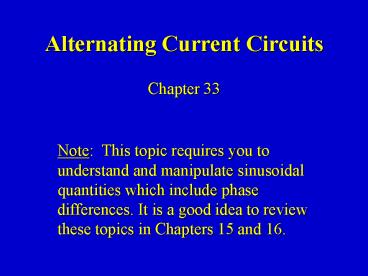Alternating Current Circuits - PowerPoint PPT Presentation
Title:
Alternating Current Circuits
Description:
I = IP sin (wt - fI ) An 'AC' circuit is one in which the driving voltage and ... fv and fI are called phase differences (these determine when. V and I are zero) ... – PowerPoint PPT presentation
Number of Views:45
Avg rating:3.0/5.0
Title: Alternating Current Circuits
1
Alternating Current Circuits
- Chapter 33
Note This topic requires you to understand and
manipulate sinusoidal quantities which include
phase differences. It is a good idea to review
these topics in Chapters 15 and 16.
2
Alternating Current Circuits
An AC circuit is one in which the driving
voltage and hence the current are sinusoidal in
time.
V VP sin (wt - fv ) I IP sin (wt - fI )
w is the angular frequency (angular speed)
radians per second. Sometimes instead of w we
use the frequency f cycles per second
Frequency ? f cycles per second, or Hertz
(Hz) w 2p f
3
Alternating Current Circuits
V VP sin (wt - fv ) I IP sin (wt - fI )
I(t)
Ip
Irms
Vrms
t
fI/w
-Ip
Vp and Ip are the peak current and voltage. We
also use the root-mean-square values Vrms
Vp / and IrmsIp / fv and fI are called
phase differences (these determine when V and I
are zero). Usually were free to set fv0 (but
not fI).
4
Example household voltage
In the U.S., standard wiring supplies 120 V at 60
Hz. Write this in sinusoidal form, assuming
V(t)0 at t0.
5
Example household voltage
In the U.S., standard wiring supplies 120 V at 60
Hz. Write this in sinusoidal form, assuming
V(t)0 at t0. This 120 V is the RMS amplitude
so VpVrms 170 V.
6
Example household voltage
In the U.S., standard wiring supplies 120 V at 60
Hz. Write this in sinusoidal form, assuming
V(t)0 at t0. This 120 V is the RMS amplitude
so VpVrms 170 V. This 60 Hz is the
frequency f so w2p f377 s -1.
7
Example household voltage
In the U.S., standard wiring supplies 120 V at 60
Hz. Write this in sinusoidal form, assuming
V(t)0 at t0. This 120 V is the RMS amplitude
so VpVrms 170 V. This 60 Hz is the
frequency f so w2p f377 s -1. So V(t) 170
sin(377t fv). Choose fv0 so that V(t)0 at
t0 V(t) 170 sin(377t).
8
Resistors in AC Circuits
EMF (and also voltage across resistor) V
VP sin (wt) Hence by Ohms law, IV/R I
(VP /R) sin(wt) IP sin(wt)
(with IPVP/R)
V
I
V and I In-phase
p
wt
2p
9
Capacitors in AC Circuits
Start from q C V
VVpsin(wt) Take derivative dq/dt C
dV/dt So I C dV/dt C VP w cos (wt)
I C w VP sin (wt p/2)
This looks like IPVP/R for a resistor (except
for the phase change). So we call Xc
1/(wC) the Capacitive Reactance
V
I
wt
p
2p
The reactance is sort of like resistance in that
IPVP/Xc. Also, the current leads the voltage by
90o (phase difference).
V and I out of phase by 90º. I leads V by 90º.
10
Capacitor Example
A 100 nF capacitor is connected to an AC supply
of peak voltage 170V and frequency 60 Hz. What
is the peak current? What is the phase of the
current? What is the dissipated power?
11
Inductors in AC Circuits
V VP sin (wt) Loop law V VL 0 where VL
-L dI/dt Hence dI/dt (VP/L)
sin(wt). Integrate I - (VP / Lw) cos (wt)
or I VP /(wL) sin (wt - p/2)
L
V
Again this looks like IPVP/R for a resistor
(except for the phase change). So we call
XL w L the Inductive
Reactance
I
p
wt
2p
Here the current lags the voltage by 90o.
V and I out of phase by 90º. I lags V by 90º.
12
Inductor Example
A 10 mH inductor is connected to an AC supply of
peak voltage 10V and frequency 50 kHz. What is
the peak current? What is the phase of the
current? What is the dissipated power?
13
(No Transcript)
14
Phasor Diagrams
A phasor is an arrow whose length represents the
amplitude of an AC voltage or current. The phasor
rotates counterclockwise about the origin with
the angular frequency of the AC quantity. Phasor
diagrams are useful in solving complex AC
circuits. The y component is the actual voltage
or current.
Resistor
Vp
Ip
w t
15
Phasor Diagrams
A phasor is an arrow whose length represents the
amplitude of an AC voltage or current. The phasor
rotates counterclockwise about the origin with
the angular frequency of the AC quantity. Phasor
diagrams are useful in solving complex AC
circuits. The y component is the actual voltage
or current.
Resistor Capacitor
Vp
Ip
Ip
w t
w t
Vp
16
Phasor Diagrams
A phasor is an arrow whose length represents the
amplitude of an AC voltage or current. The phasor
rotates counterclockwise about the origin with
the angular frequency of the AC quantity. Phasor
diagrams are useful in solving complex AC
circuits. The y component is the actual voltage
or current.
Resistor Capacitor Inductor
Vp
Vp
Ip
Ip
Ip
w t
w t
w t
Vp
17
i
i
time
i
i
LC Circuit
i
i
18
Analyzing the L-C Circuit
Total energy in the circuit
N o change in energy
Differentiate
19
Analyzing the L-C Circuit
Total energy in the circuit
N o change in energy
Differentiate
20
Analyzing the L-C Circuit
Total energy in the circuit
N o change in energy
Differentiate
21
Analyzing the L-C Circuit
Total energy in the circuit
N o change in energy
Differentiate
The charge sloshes back and forth with frequency
w (LC)-1/2































